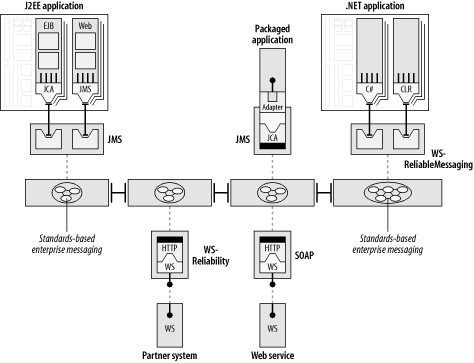Chapter 8. Protocols, Messaging, Custom Adapters, and Services
This chapter will explore how the ESB can extend its MOM core to create the flexibility in protocols necessary to connect to applications in an adaptable and nonintrusive way, through protocol handlers and messaging patterns. This includes an explanation of how XML and SOAP messaging can be integral parts of an ESB strategy, yet also be flexible enough to carry other data formats such as EDI X12 messages. This chapter also shows the details of a partner integration using an ESB, and examines the use of third-party adapters and custom integration services for integrating with backend systems such as SAP.
The ESB MOM Core
At the core of the ESB communications layer is a MOM infrastructure that is capable of supporting a variety of industry-standard access mechanisms and protocols (Figure 8-1). Think of the MOM as a multiprotocol messaging bus that supports asynchronous delivery of messages with configurable QoS options ranging from exactly-once delivery with transactional integrity through high-performance, low-latency best-effort delivery (a.k.a. at-most-once delivery). The MOM support underneath an ESB should support scalable clustering that is capable of being deployed across the various types of geographical layouts that have been discussed throughout this book.

Figure 8-1. An enterprise MOM at the core of the ESB architecture ...